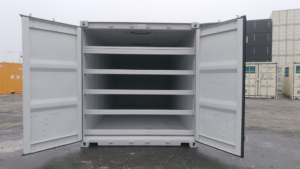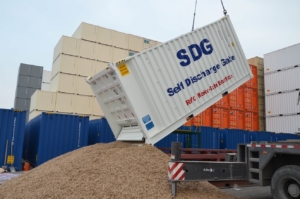The global demand for shipping containers has surged in recent years, driven by the growth of international trade and the need for efficient, cost-effective storage and transportation solutions. Container factories have become critical in meeting this demand by producing high-quality containers that can withstand the rigors of global shipping. In this article, we will explore the detailed manufacturing process of a container factory, focusing on the various stages involved in creating these essential units. By the end of this discussion, you will have a clear understanding of how a container factory operates and the critical role it plays in the logistics industry.
1. Raw Material Procurement and Preparation
The journey of container manufacturing in a container factory begins with the selection and procurement of raw materials. The primary material used is corten steel, a type of weather-resistant steel known for its exceptional durability and corrosion resistance. This is crucial as containers are exposed to harsh environmental conditions, including saltwater, extreme temperatures, and mechanical wear during shipping.
Once the steel arrives at the container factory, it undergoes a rigorous inspection to ensure it meets industry standards. The steel sheets are then cut into specific dimensions using high-precision cutting machines. Accuracy in this step is paramount, as the correct sizing of steel sheets directly influences the structural integrity and assembly of the final container.

2. Panel Fabrication
In a container factory, panel fabrication is one of the most critical steps. The container’s structure is composed of various panels, including the side walls, roof, floor, and doors. Each of these components is fabricated separately within the container factory.
- Side Walls: The corten steel sheets are cut to form the side walls. These sheets are typically corrugated to increase their strength and durability. The corrugation process involves passing the steel sheets through rollers that press the material into a series of parallel ridges and grooves. This design not only reinforces the walls but also helps in distributing stress evenly across the container’s structure.
- Roof Panel: The roof panel is also made from corten steel, but it is generally a flat sheet without corrugation. The panel is cut to the exact size required for the container’s roof, ensuring a snug fit during assembly.
- Floor Panel: The floor of a container is usually made from treated plywood or bamboo, which is reinforced with steel cross members. In some cases, a container factory may produce containers with steel floors for added durability. The wood is treated to resist moisture and pests, ensuring longevity even in adverse conditions.
- Doors: The container doors are fabricated from corten steel and are equipped with locking mechanisms, hinges, and rubber seals. These components are essential for ensuring the container is secure and weatherproof.
3. Frame Assembly
With the panels fabricated, the next stage in a container factory is the assembly of the container frame. The frame provides the skeleton of the container and is crucial for maintaining its structural integrity.
- Corner Posts: The corner posts are vertical steel beams that are welded to the four corners of the container. These posts bear the weight of the container when it is stacked, making them one of the most critical components in the frame assembly.
- Top and Bottom Rails: The top and bottom rails are horizontal steel beams that connect the corner posts. The top rails support the roof panel, while the bottom rails serve as the foundation for the floor panel.
- Cross Members: Steel cross members are welded between the bottom rails to provide additional support for the floor panel. These members help distribute the load across the container’s base, preventing the floor from sagging under heavy weight.
Once the frame components are in place, they are welded together to form the basic structure of the container. The welding process in a container factory is typically done using automated welding machines to ensure precision and consistency.
4. Panel Assembly
With the frame complete, the next step in a container factory is panel assembly. During this stage, the previously fabricated panels are attached to the frame.
- Side Walls: The corrugated side walls are welded to the corner posts and top and bottom rails. The welding process must be done carefully to ensure a tight seal, preventing water or air from entering the container.
- Roof Panel: The roof panel is placed on top of the frame and welded to the top rails and corner posts. The welds must be strong enough to withstand the weight of any cargo placed on top of the container during stacking.
- Floor Panel: The floor panel is installed last. It is secured to the cross members using bolts or screws, depending on the container’s design. In some cases, the floor may also be welded to the frame for added stability.
- Doors: The doors are attached to the frame using heavy-duty hinges. The locking mechanisms are installed, and rubber seals are added around the edges to ensure the doors are watertight.

5. Surface Treatment
Once the container is fully assembled, the next step in the container factory is surface treatment. This process is critical for protecting the container from rust, corrosion, and other environmental factors.
- Sandblasting: The entire surface of the container is sandblasted to remove any rust, dirt, or contaminants. Sandblasting also roughens the surface, making it easier for paint to adhere.
- Priming: After sandblasting, a layer of primer is applied to the container’s surface. The primer serves as a base coat that enhances the adhesion of the topcoat and provides an additional layer of protection against corrosion.
- Painting: The container is then painted with a topcoat of weather-resistant paint. The paint not only gives the container its color but also provides a protective barrier against the elements. In most cases, containers are painted in standard colors like blue, green, or red, although custom colors can also be applied based on customer specifications.
- Markings: The final step in surface treatment involves applying necessary markings, such as the container’s unique identification number, the owner’s logo, and handling instructions. These markings are essential for identification and logistics management and are carefully stenciled or painted on in the container factory.
6. Inspection and Quality Control
Before the container leaves the factory, it undergoes a thorough inspection and quality control process. This is a critical step in the container factory to ensure that the container meets all industry standards and customer specifications.
- Dimensional Inspection: The container’s dimensions are checked to ensure they comply with international standards. This includes verifying the length, width, height, and internal volume.
- Structural Integrity: The welds, joints, and overall structure of the container are inspected for any defects or weaknesses. The container must be able to withstand the stresses of loading, unloading, and transportation without compromising its integrity.
- Surface Inspection: The surface of the container is inspected for any paint defects, such as bubbles or cracks. The container factory also checks that the markings are clear and correctly positioned.
- Functional Testing: The doors and locking mechanisms are tested to ensure they function properly and provide a secure seal. The rubber seals around the doors are also inspected for any gaps or defects that could allow water or air to enter the container.
7. Delivery and Deployment
Once the container has passed all quality control checks, it is ready for delivery. In a container factory, the delivery process involves several steps:
- Packaging: The container is typically wrapped in protective material to prevent damage during transportation. This may include plastic sheeting or other protective coverings.
- Loading: The container is loaded onto a truck, train, or ship for delivery to the customer. The loading process must be done carefully to avoid damaging the container or its contents.
- Deployment: Upon arrival at its destination, the container is deployed for its intended use, whether for storage, transportation, or conversion into a mobile office or housing unit. The container factory often provides support during this phase to ensure the container is set up and utilized correctly.
Conclusion
The manufacturing process of a container factory is a complex and highly specialized operation that requires precision, expertise, and attention to detail. From the procurement of raw materials to the final inspection and delivery, each step plays a crucial role in ensuring that the containers produced are of the highest quality and capable of meeting the demands of global shipping and storage. As the logistics industry continues to grow, the importance of container factories will only increase, making them an essential component of the modern supply chain.
CIMC Yang Zhou Base is a leading manufacturer of container factories and various other standard and special logistics equipment. With years of experience in the industry, it focuses on the design, production, and distribution of high-quality innovative products that meet the specific needs of customers.
If you need high-quality and innovative logistics equipment, including refrigerated containers, cold chain equipment, containerized equipment integration, modular buildings, etc., База CIMC Ян Чжоу is your best choice. We welcome inquiries from customers all over the world and look forward to the opportunity to cooperate with you.


